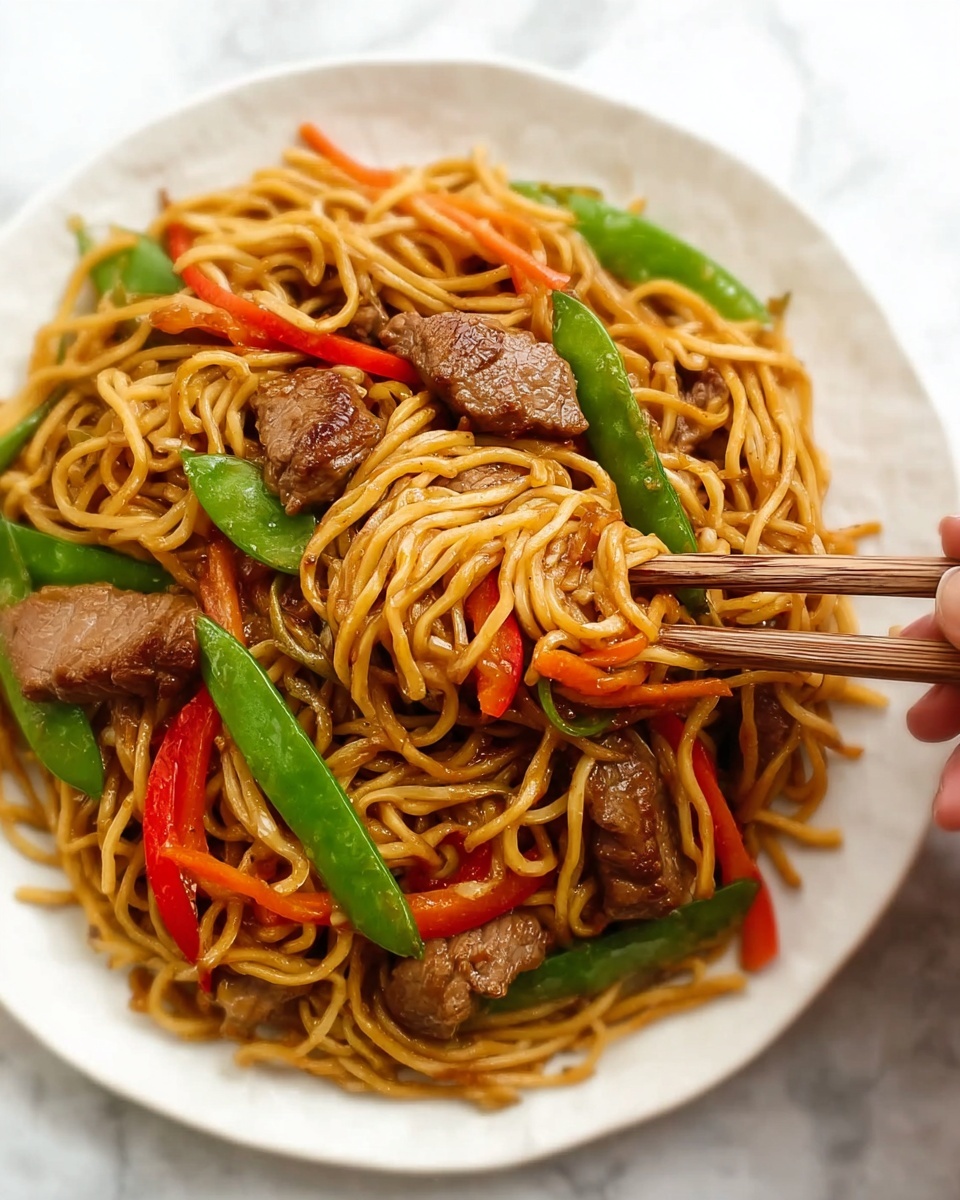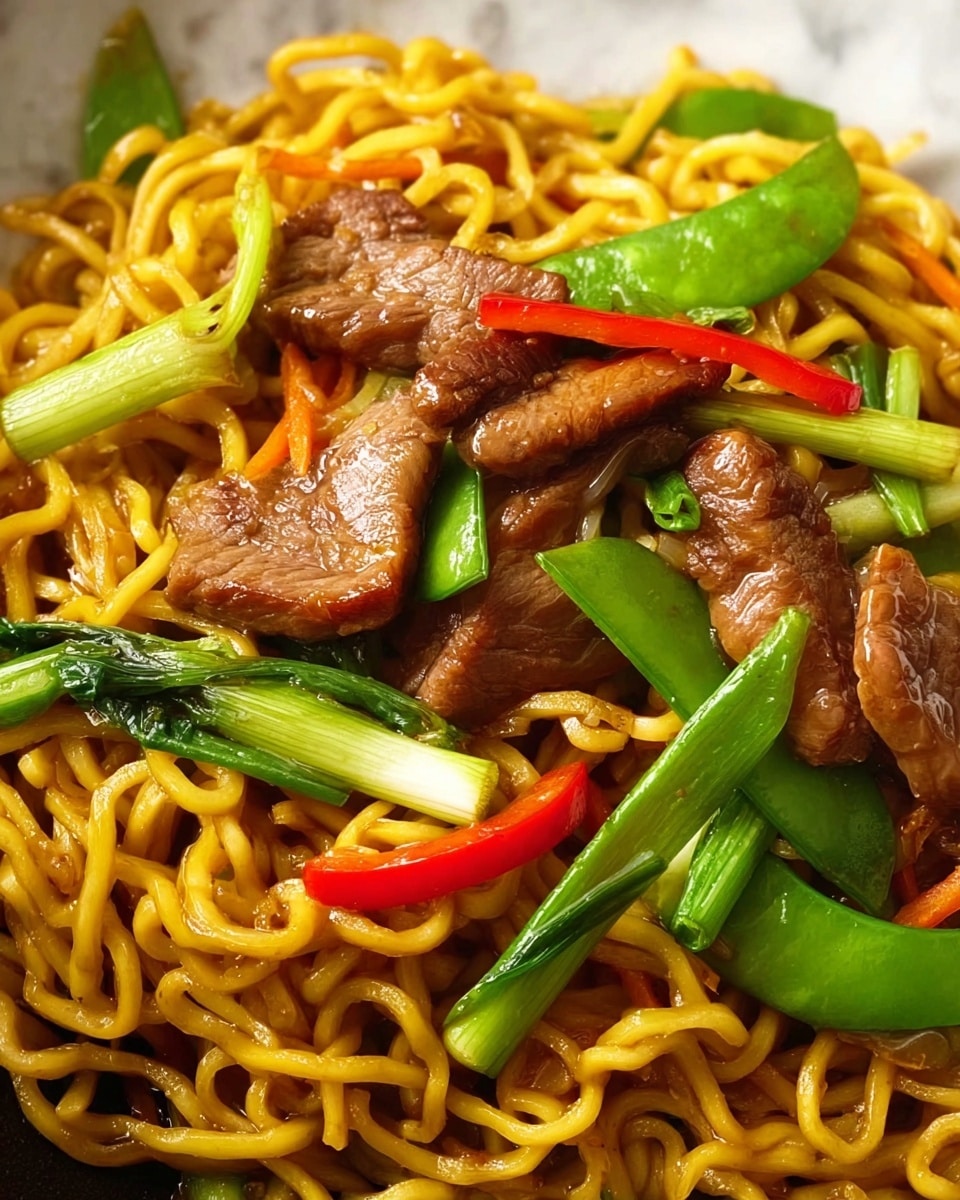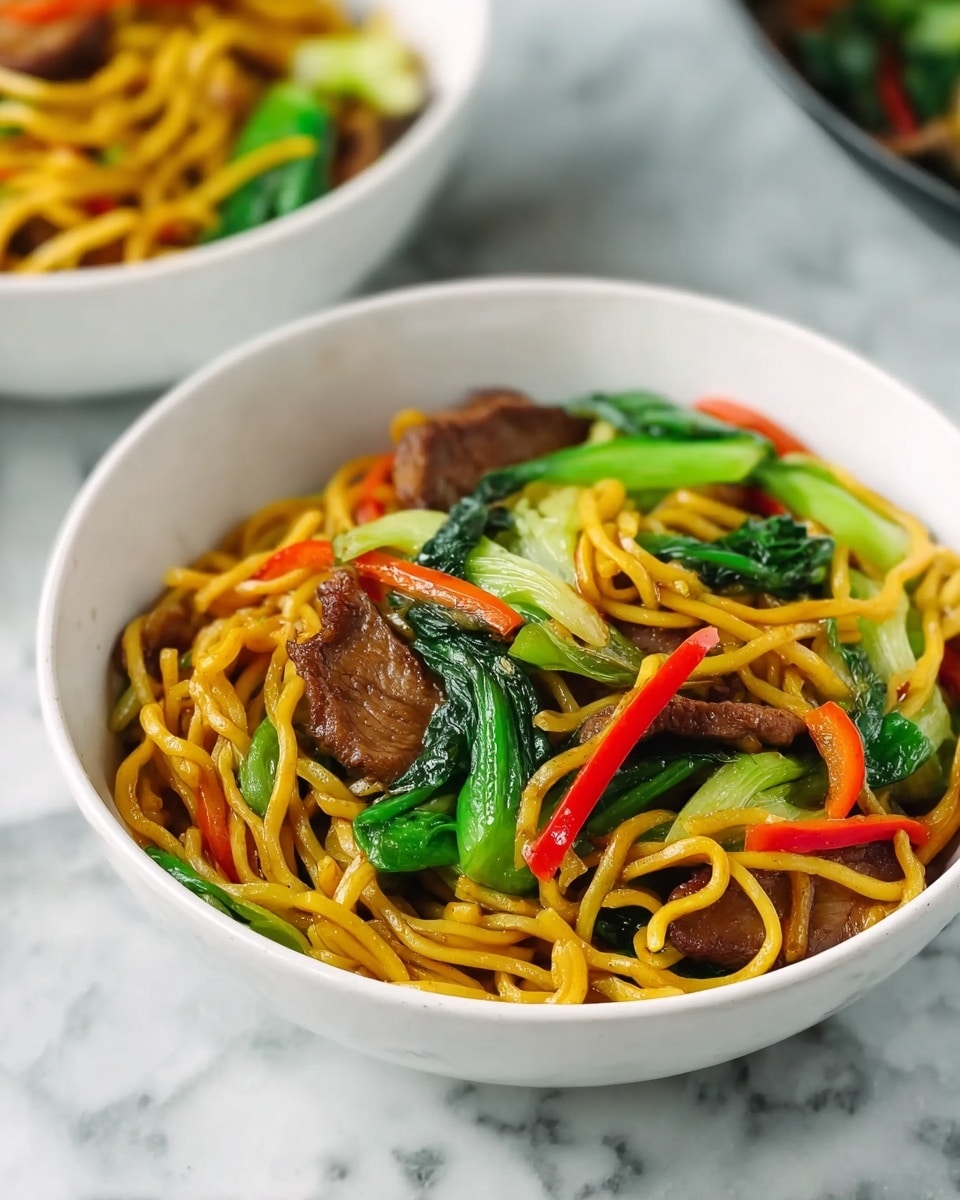If you’re searching for a quick, flavorful, and utterly satisfying noodle dish, this Beef Lo Mein Recipe is an absolute game changer. I love this recipe because it strikes the perfect balance between tender beef, crisp veggies, and silky noodles coated in a savory sauce that’s downright addictive. Whether you’re making a weeknight dinner or impressing friends, this Beef Lo Mein always delivers the goods and won’t keep you in the kitchen for hours—let me walk you through it!
Why You’ll Love This Recipe
- Quick and Easy: You’ll have dinner on the table in about 20 minutes, perfect for busy nights.
- Customizable Veggies: Feel free to swap or add your favorite vegetables to suit your tastes.
- Tender Beef Every Time: The marinade and quick sear ensure the beef stays juicy and flavorful without overcooking.
- Authentic Flavor: The blend of soy sauces, oyster sauce, and a touch of Shaoxing wine brings out a classic Chinese takeout vibe you’ll crave again and again.
Ingredients You’ll Need
For this Beef Lo Mein recipe, I like to keep the ingredients fresh and straightforward—mostly staples you can find easily. The combination of fresh noodles and crisp vegetables really brings this dish to life, and choosing a tender cut of beef is key.
- Fresh Lo Mein Noodles: These give the dish its chewy, soft texture. If you can’t find fresh, cooked egg noodles work perfectly too.
- Beef Sirloin or Tender Cut: Thinly sliced against the grain, this is crucial for tender bites.
- Mushrooms: I use fresh sliced ones for earthiness and texture.
- Spring Onions: Adds freshness and a subtle crunch when tossed in at the end.
- Bell Pepper: Julienned for sweetness and color contrast.
- Cabbage Leaves: Thinly sliced to soak up the sauce and add a slight crunch.
- Snow Peas: Their natural sweetness pairs beautifully with the savory sauce.
- Carrot: Julienned, they add a lovely vibrant color and a mild sweetness.
- Vegetable Oil: For stir-frying without overpowering flavors.
- Light Soy Sauce: The base salty sauce that balances everything.
- Sesame Oil: Just a bit to infuse a nutty aroma.
- Dark Soy Sauce: Adds depth and color.
- Oyster Sauce: Brings that umami punch every lo mein needs.
- Sugar: Balances saltiness and rounds out the flavor.
- Shaoxing Wine: This is my secret aroma booster, but you can substitute it with rice vinegar or water if you prefer no alcohol.
- White Pepper: A subtle heat that plays nicely in this recipe.
- Corn Starch and Baking Soda: Used in the marinade to tenderize the beef wonderfully.
Variations
I love experimenting with this Beef Lo Mein recipe, and honestly, it’s pretty forgiving. You can easily adjust the vegetables and protein to suit what you have on hand or dietary needs.
- Make it Chicken Lo Mein: I’ve swapped beef for chicken breast or thighs with great results—just adjust cooking time accordingly.
- Vegetarian Version: Skip the beef and add tofu or extra mushrooms for a hearty plant-based meal my family adores.
- Spicy Kick: I like to add sliced chili peppers or a dash of chili oil if I’m craving heat.
- Gluten-Free Option: Use gluten-free noodles and tamari instead of soy sauce to make it friendly for gluten sensitivities.
How to Make Beef Lo Mein Recipe
Step 1: Prep Your Noodles and Sauce
Start by blanching your fresh lo mein noodles in hot water for about 1-2 minutes. This softens them just right without becoming mushy. I like to drizzle a little sesame oil over the noodles afterward and gently toss them so they don’t stick together—trust me, it makes a huge difference when you stir-fry.
Step 2: Slice and Marinate the Beef
Cut the beef thinly against the grain—I promise this makes the beef tender and easy to chew. Combine a tablespoon of the sauce mix with corn starch and a pinch of baking soda to marinate the beef for 10 to 15 minutes. I discovered this tenderizing trick after struggling with tough beef for years, and it really turns out silky every time.
Step 3: Stir-Fry Beef and Vegetables in Sequence
Heat up your wok or large pan to medium-high and add the vegetable oil. When it’s hot, add the beef slices, flattening them slightly so they get a nice sear. You’ll cook them about 1-2 minutes per side, just enough to brown without overcooking. Then toss in your vegetables, starting with the harder ones like carrots, bell pepper, and cabbage. Cook for a couple minutes until they start to soften but still keep their crunch—this layering method is a game changer for texture.
Step 4: Combine Noodles and Sauce
Make a little well in the center of the wok, add your noodles, and pour in the sauce mixture. Toss everything vigorously for 2-3 minutes so the noodles get coated evenly and the flavors meld together beautifully. You’ll see the sauce thicken slightly as it heats up and clings to every ingredient—you’ll want to dig right in.
Finally, remove from heat and serve immediately. I usually sprinkle some chopped spring onions and a drizzle of chili oil on top for extra freshness and a touch of heat.
Pro Tips for Making Beef Lo Mein Recipe
- Noodles Don’t Overcook: Keep an eye on blanched noodles—slightly underdone is perfect because they’ll cook more in the wok.
- Thin Beef Slices: If you freeze your beef for 30 minutes beforehand, slicing thinly against the grain becomes much easier.
- High Heat Stir-Fry: Don’t overcrowd the pan; cook in batches if needed to get that perfect sear and maintain veggie crunch.
- Sauce Balance: Taste your sauce before adding; adjust sugar or soy to get the sweet-salty harmony you love.
How to Serve Beef Lo Mein Recipe

Garnishes
I usually top my Beef Lo Mein with freshly chopped spring onions because they add a pop of brightness and just the right crunch. If you’re feeling adventurous, a drizzle of chili oil or a sprinkle of toasted sesame seeds on top really elevates the dish. When my family’s gathered, I often serve alongside pickled ginger for a little tang.
Side Dishes
This recipe stands well on its own, but if I’m serving it at a dinner party, I like to add a simple cucumber salad or stir-fried bok choy on the side. Also, crispy spring rolls or veggie dumplings round out the meal beautifully without too much extra effort.
Creative Ways to Present
For special occasions, I’ve served this beef lo mein in warm Chinese-style bowls with carved cucumber garnishes and edible flowers to impress guests. Another favorite is layering the noodles on a large platter, garnished with fresh herbs and chili threads for a colorful family-style presentation—that always gets compliments!
Make Ahead and Storage
Storing Leftovers
I store leftover Beef Lo Mein in airtight containers in the fridge, where it stays good for about 2-3 days. If you notice the noodles getting a little sticky the next day, just toss in a splash of water before reheating to bring back their moisture.
Freezing
Freezing Beef Lo Mein is possible but not my favorite. The texture of noodles and vegetables can change a bit after thawing. If you do freeze, separate the beef and noodles from the veggies and reheat them gently to keep things tasting fresh.
Reheating
For leftovers, I reheat my Beef Lo Mein in a hot wok or skillet with a drizzle of oil over medium-high heat. Tossing it quickly keeps the noodles from getting soggy and revives the slightly crisp veggies. Microwave reheating works too, but you might lose some texture.
FAQs
-
Can I use dried noodles instead of fresh for this Beef Lo Mein Recipe?
Absolutely! Dried egg noodles work just fine; just prepare them according to the package instructions before stir-frying. I recommend cooking them until just al dente, so they don’t turn mushy when tossed with the sauce.
-
What cut of beef works best for tender Beef Lo Mein?
Sirloin, tenderloin, or rump cuts are my go-to choices because they cook quickly and stay tender when sliced thin against the grain. Avoid tougher cuts unless you’re willing to marinate longer or slow-cook separately.
-
Is Shaoxing wine necessary, and what can I substitute it with?
Shaoxing wine adds authentic aroma and depth, but if you want to avoid alcohol, substituting with water or a little rice vinegar works well without compromising too much on flavor.
-
Can I make this Beef Lo Mein Recipe vegetarian?
Definitely! Skip the beef and use tofu, tempeh, or extra mushrooms for protein. Just adjust your sauce and cooking time slightly. It’s still super tasty and satisfying.
-
How do I prevent the noodles from sticking together?
A good trick is to toss the noodles with a little sesame oil right after blanching; this coats them and keeps them from clumping during stir-frying. Also, don’t overcook the noodles initially—they should be just tender.
Final Thoughts
This Beef Lo Mein recipe is one of those dishes that’s become a staple in my kitchen—so fast, so delicious, and so satisfying. When I first tried making lo mein at home, I struggled to get the beef tender and the noodles perfect, but with these tips and a bit of patience, you’ll nail it in no time. I absolutely love how this dish can be customized and brought to life with simple ingredients you likely have on hand. Give it a try—you’ll soon find that homemade Beef Lo Mein beats takeout any day, and your family will be asking for seconds, guaranteed!
Print
Beef Lo Mein Recipe
- Prep Time: 10 minutes
- Cook Time: 10 minutes
- Total Time: 20 minutes
- Yield: 2 servings 1x
- Category: Main Dish
- Method: Stovetop
- Cuisine: Chinese
Description
This Beef Lo Mein recipe combines tender slices of beef with fresh vegetables and flavorful noodles tossed in a savory sauce. The dish features a quick and easy stir-fry technique that brings out the best textures and tastes, making it an ideal weeknight dinner. Using a classic sauce mixture with soy, oyster sauce, and sesame oil, this recipe highlights authentic Chinese flavors with a satisfying balance of meat, veggies, and noodles.
Ingredients
Noodles
- 400 gram (14 oz) Fresh Lo Mein noodles (or cooked egg noodles)
Beef
- 250 gram (9 oz) Beef sirloin, tenderloin, rump, or any tender meat cut
Vegetables
- 3–4 Mushrooms, sliced
- 2–3 Spring onions, cut into 2” pieces
- 1 Bell pepper, julienned
- 2–3 Cabbage leaves, thinly sliced
- 5–6 Snow peas
- 1 Small carrot, julienned
Oils
- 2 tbsp Vegetable oil
- 1 tbsp Sesame oil (for sauce and noodles)
Sauce Mix
- 2 tbsp Light soy sauce
- 1 tbsp Sesame oil
- 2 tsp Dark soy sauce
- 4 tbsp Oyster sauce
- 1 tbsp Sugar
- 1 tbsp Shaoxing wine (or water or rice vinegar as substitute)
- ¼ tsp White pepper
Beef Marinade
- 1 tbsp Sauce mix (from above)
- 1 tsp Corn starch
- ¼ tsp Baking soda
Instructions
- Prepare Noodles: Blanch the noodles with hot water for 1-2 minutes. Then drizzle a bit of sesame oil over the noodles, mix well, and set aside to prevent sticking.
- Make Sauce Mix: Combine all the sauce ingredients—including light and dark soy sauces, sesame oil, oyster sauce, sugar, Shaoxing wine (or substitute), and white pepper—in a small bowl. Set aside for later use.
- Prepare Vegetables and Beef: Wash and cut all vegetables into appropriate slices. Slice the beef thinly against the grain to ensure tenderness.
- Marinate Beef: In a bowl, mix the sliced beef with 1 tablespoon of the sauce mixture, 1 teaspoon corn starch, and ¼ teaspoon baking soda. Let this marinate for 10-15 minutes to tenderize and flavor the beef.
- Cook Beef: Heat a wok or large pan over medium-high heat and add 2 tablespoons of vegetable oil. Add the marinated beef slices, flatten them in the pan, and sear for 1-2 minutes on one side. Keep stir-frying for another 1-2 minutes until beef is mostly cooked through.
- Stir-fry Vegetables: Add the prepared vegetables to the wok starting with the hardest ones. Stir-fry for 1-2 minutes to soften slightly while keeping crisp.
- Add Noodles and Sauce: Make space in the middle of the wok and add the noodles. Pour the sauce mixture over the noodles and toss everything together carefully.
- Combine and Finish Cooking: Toss all ingredients and noodles well for 2-3 minutes until the noodles are cooked through and all flavors meld together.
- Serve: Remove from heat and transfer to a serving plate. Optionally, top with extra chopped spring onions and chili oil to taste. Serve immediately and enjoy!
Notes
- Lo Mein Noodles: Fresh lo mein noodles are commonly available in Chinese or Oriental grocery stores. They are also labeled as Hokkien noodles sometimes. You may use fresh, frozen, or dry egg noodles as an alternative, but cook them according to package instructions before stir-frying.
- Shaoxing Wine: This traditional Chinese rice wine adds aroma and depth. If avoiding alcohol, substitute with water or rice vinegar for a non-alcoholic version without compromising the dish’s flavor drastically.
- Beef Cuts: Use tender cuts like sirloin, tenderloin, or rump for best texture in this quick stir fry.
- Vegetable Prep: Slice vegetables evenly for consistent cooking times and maintain a slight crunch for a pleasant texture contrast.
Nutrition
- Serving Size: 1 serving (approx. 300g)
- Calories: 480 kcal
- Sugar: 7 g
- Sodium: 900 mg
- Fat: 14 g
- Saturated Fat: 3.5 g
- Unsaturated Fat: 9 g
- Trans Fat: 0 g
- Carbohydrates: 55 g
- Fiber: 5 g
- Protein: 30 g
- Cholesterol: 65 mg




Your email address will not be published. Required fields are marked *